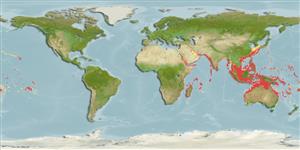Common names from other countries
Environment: milieu / climate zone / depth range / distribution range
Ecologia
marinhas; estuarina associadas(os) a recifes; intervalo de profundidade 2 - 178 m (Ref. 86942), usually 15 - 75 m (Ref. 9710). Tropical; 30°N - 35°S
Indo-Pacific: East Africa and Persian Gulf to the Society Islands, north to southern Japan, south to Lord Howe Island. Throughout Micronesia.
Tamanho / Peso / Idade
Maturity: Lm ? range ? - ? cm
Max length : 25.0 cm TL macho/indeterminado; (Ref. 5372); common length : 15.0 cm TL macho/indeterminado; (Ref. 5450)
Espinhos dorsais (total) : 11 - 12; Raios dorsais (total) : 22 - 27; Espinhos anais: 3; Raios anais : 17 - 19.
Inhabit deep, protected lagoons and channels, and the deeper parts of outer reef slopes. Juveniles are often solitary while adults occur in pairs (Ref. 1602, 48636). A planktivorous species that generally remains within a few meters of the reef. Juveniles may sometimes pick on parasites on the epidermis of other fish (Ref. 5503). Oviparous (Ref. 205). Form pairs during breeding (Ref. 205).
Ciclo de vida ou comportamento de acasalamento
Maturities | Reprodução | Spawnings | Egg(s) | Fecundities | Larvas
Form pairs during breeding (Ref. 205).
Steene, R.C., 1978. Butterfly and angelfishes of the world. A.H. & A.W. Reed Pty Ltd., Australia. vol. 1. 144 p. (Ref. 4859)
Status na Lista Vermelha da UICN (Ref. 130435)
CITES (Ref. 128078)
Not Evaluated
Ameaça para os humanos
Harmless
Uso pelos humanos
Pescarias: pouco comercial; Aquacultura: espécies comerciais; Aquário: Espécies comerciais
Ferramentas
Relatórios especiais
Baixar XML
Fontes da internet
Estimates based on models
Preferred temperature (Ref.
115969): 23.6 - 29.1, mean 27.9 (based on 2680 cells).
Índice de diversidade filogenética (Ref.
82804): PD
50 = 0.5039 [Uniqueness, from 0.5 = low to 2.0 = high].
Bayesian length-weight: a=0.02291 (0.01452 - 0.03614), b=3.04 (2.90 - 3.18), in cm Total Length, based on LWR estimates for this species & (Sub)family-body (Ref.
93245).
Nível Trófico (Ref.
69278): 3.8 ±0.37 se; based on food items.
Resiliência (Ref.
120179): Elevada, tempo mínimo de duplicação da população menor que 15 meses (Preliminary K or Fecundity.).
Fishing Vulnerability (Ref.
59153): Low vulnerability (15 of 100).
